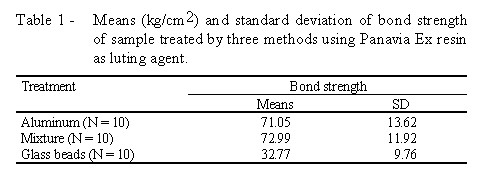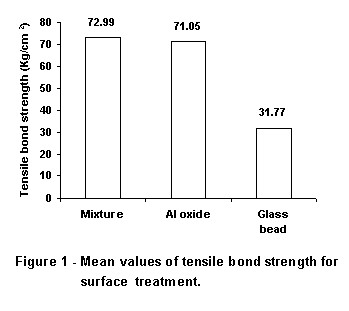|
Tensile Bond Strength of Panavia Ex to a Ni-Cr Alloy Using Different Surface Treatments
Claudia Mendonça PINTO COELHO[1]
José Henrique RUBO[2]
Luiz Fernando PEGORARO[2]
[1]Hospital de Reabilitação,
[2]Departamento de Prótese, Faculdade de Odontologia, USP,
Bauru, SP, Brasil
Braz Dent J (1995) 6(2): 111-114 ISSN 0103-6440
| Introduction | Material/Methods
| Results and Discussion | Clinical
Implications | Conclusions | References
|
Panavia Ex resin has been claimed to require only air abrasion of the
alloy with 50 µm aluminum oxide particles to reach acceptable bond
strength values. This study discusses the consequences of changes in the
type of air abrasion and surface oxidation of the alloy. Thirty pairs of
discs of a Ni-Cr alloy were treated by three methods: 1) air abrasion with
50 µm aluminum oxide (control); 2) air abrasion with glass beads;
3) air abrasion with a mixture of aluminum oxide and glass beads (ratio
1:1). The Tukey test showed statistical differences only for air abrasion
with glass beads.
Key words: resin-bonded prostheses, surface treatments.
Introduction
The construction of resin-bonded prostheses has been simplified with the
development of resins that bond chemically to both enamel and air-abraded
base metal alloys (Omura et al., 1984). One of those resins, Panavia Ex,
has been reported to require only air abrasion of the alloy with 50 µm
aluminum oxide particles and ultrasonic cleaning to reach acceptable bond
strength values (Pegoraro and Barrack, 1987).
However, much research has been carried out (Tanaka et al., 1986; Wiltshire,
1986; Caeg et al., 1990; Kohli et al., 1990; Lin et al., 1990; Turner and
Sinclair, 1990; Kolodney et al., 1992) in order to determine which surface
treatment would be the most suitable. The purpose of this study was to
evaluate the effect of different types of air abrasion and surface oxidation
treatment on the bond strength of Panavia Ex to a Ni-Cr alloy.
Material and Methods
Thirty pairs of discs of a Ni-Cr alloy (Durabond MS, Dental Gaúcho
Marquart e Cia Ltda, São Paulo) were obtained from wax patterns
made in a matrix 2.0 mm in thickness and 10.0 and 12.0 mm in diameter.
A standardized loop was placed over the discs as an attachment to the testing
machine.
After casting, the discs were cleaned and their surfaces ground with
a 600-grit sandpaper to obtain two parallel flat surfaces. They were then
subjected to four thermal cycles to simulate a porcelain firing surface.
In order to align the two discs during cementation a metallic cylinder
was used with a central slit and two concentric bases with two different
diameters: the bottom with 10.0 mm in diameter by 3.0 mm in height and
the upper 12.0 mm in diameter by 1.0 mm in height.
To standardize the space for the luting agent, we used the methodology
described by Rubo (1989). The two metal specimens were fixed surface to
surface with 60-µm thick adhesive tape (Scotch double face adhesive
tape, 3M Ltda). To keep these discs in position inside the cylinder, acrylic
resin (Duralay, Relliance Dental Mfg Co., Worth, IL, USA) was added on
the external surface of discs. The larger disc was held in position by
the shoulder in the cylinder. After curing the resin the tape was removed
and the space for the luting agent standardized.
Before cementation the surfaces were treated by three methods: 1) sandblasted
with 50 µm aluminum oxide (Odonto Larcon, São Paulo) with
75 lbs air pressure; 2) sandblasted with glass beads (Odonto Larcon, São
Paulo); 3) sandblasted with a mixture of aluminum oxide and glass beads
(ratio 1:1). All of the specimens were ultrasonically cleaned in distilled
water for 2 min before cementation.
Dental Panavia Ex (Kuraray Co., Japan) was mixed according to the manufacturer's
instructions, applied to the internal surfaces of the two discs and kept
under a 5-kg load. The discs were stored in distilled water at 37°C
for 24 hours and the tensile bond strength was measured in a universal
testing machine (Dinamômetros Kratos Ltda, São Paulo) at a
crosshead speed of 0.5 mm/min.
Results and Discussion
Tensile bond strength of the samples treated by three methods (Table 1)
were compared by one-way analysis of variance to verify the difference
among surface treatments (Table 2). Analysis identified significant differences
between treatments and interactions between them. The Tukey test for multiple
comparisons revealed significant differences between the following treatments:
1) aluminum oxide x glass beads; 2) mixture of aluminum oxide and glass
beads x glass beads.


Improper surface treatment of the alloy has been responsible for failures
in the interface metal/luting agent. The correct use of abrasive powders
in the dental laboratory is essential to improve the bond strength of metal/resin/enamel.
From the data obtained it could be observed that the surface treatment
with glass beads decreased the bond strength more than 50% when compared
to other conditions (Figure 1). Since the glass beads are less abrasive
than the aluminum oxide particles they could smooth the surface whereas
the aluminum oxide would roughen it. It could be concluded that the aluminum
oxide not only increases the reaction on the surface with resin but also
creates micromechanical retention increasing bond strength.

The devices used for air abrasion are often composed of three compartments:
one with aluminum oxide, one with glass beads and the third which collects
the other two after their use. Negligence in the use of this device may
result in improper air abrasion. Regardless of the result obtained with
the mixture of aluminum oxide and glass beads, its use is not advisable.
The ratio between the two powders can become critical compromising the
bond strength. The powders used in this study were mixed before use.
Therefore, it can be concluded that the bond strength between resin
and metal is due in part to the mechanical retention obtained by sandblasting
and in part to chemical adhesion of the resin to the metal.
Differences found between this study and others in the literature, including
Tanaka et al. (1986) who found values 3 times superior, can be explained
by differences in the methodology used, crosshead speed of the testing
machine, type of alloy and resin, shape and size of specimens. This makes
direct comparisons impossible. However, there is agreement with the study
of Rubo (1989) (mean value of 78.30 kg/cm2) who used the same methodology.
Clinical Implications
Since the development of resin-bonded prostheses, researchers are seeking
an effective and easy-to-use system of bonding resin to metal. Air abrasion
with aluminum oxide has satisfactorily fulfilled these conditions. At this
time any attempt to improve this system has shown to be unnecessary. On
the other hand, attention to correct air abrasion is imperative for success.
Conclusions
1) Bond strength of the samples was greatest with a mixture of aluminum
oxide and glass beads 1:1, followed by aluminum oxide, and glass beads.
2) The Tukey test showed statistical differences only for air abrasion
with glass beads.
References
Caeg C, Leinfelder KF, Lacefield WR, Bell W: Effectiveness of a method
used in bonding resins to metal. J Prosthet Dent 64: 37-44, 1990
Kohli S, Levine WA, Grisius RJ, Fenster RK: The effect of three different
surface treatments on tensile strength of the resin bond to nickel-chromium-beryllium
alloy. J Prosthet Dent 63: 4-8, 1990
Kolodney Jr H, Pucket AD, Breazeale MS, Patterson KL, Lenz DL: Shear
bond strengths of prosthodontic adhesive systems to a nickel-chromium-beryllium
alloy. Quintessence Int 23: 65-69, 1992
Lin T, Chang H, Chung K: Interfacial strengths of various alloy surface
treatments for resin-bonded fixed partial dentures. J Prosthet Dent 64:
158-162, 1990
Omura J, Yamauchi J, Harada I, Wada T: Adhesive and mechanical properties
of a new dental adhesive. J Dent Res 63: 233 (abstract), 1984
Pegoraro LF, Barrack G: A comparison of bond strengths of adhesive cast
restorations using different designs, bonding agents, and luting resins.
J Prosthet Dent 57: 133-138, 1987
Rubo JH: Tensile bond strength of Panavia Ex to various dental alloys.
Master's thesis, School of Dentistry of Bauru, University of São
Paulo, Brazil, 1989
Tanaka J, Fujiyama E, Shimizue A, Takaki A, Atsuta M: Surface treatment
of non-precious alloys for adhesion-fixed partial dentures. J Prosthet
Dent 55: 456-462, 1986
Turner CH, Sinclair L: Sprayed opaque porcelain as a surface for resin-bonded
restorations. Int J Prosthodont 3: 384-390, 1990
Wiltshire WA: Tensile bond strengths of various alloy surface treatments
for resin-bonded bridges. Quintessence Dent Tech 10: 227-232, 1986
Correspondence:Claudia Mendonça Pinto Coelho, Rua Quintino
Bocaiuva, 1006, 14015-160, Ribeirão Preto, SP, Brasil.
|

